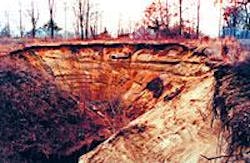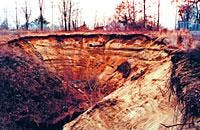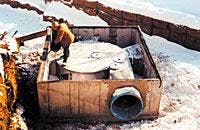Hydro-Brakes Slow Stormwater Flow at Steep Site
When the area around End Street in Chicopee, MA, was developed for residential use in the late 1950s, the developer installed a stormwater drainage system with a 24-inch drainpipe outfall that discharged into a ravine leading to a nearby stream. Over time the outfall site eroded from a small ditch into a small channel, which then turned into a larger gully. By the late 1990s, water had eroded the gully site into a huge scour hole with banks of unstable sandy soil that were 30 feet high, 150 feet long and 70 feet apart.
"It was like a mini Grand Canyon," said an engineer who worked on the project, noting that the change in elevation from the top of the ravine to the outlet of the ravine was more than 80 feet. The scour hole was undercutting the drainpipe itself.
"We got to the point where we were just calling it 'the hole', " said Chicopee's Department of Public Works Supervisor Stanley Kulig. He and other city officials were concerned about the public safety hazard that the hole posed. "It was an attractive nuisance for kids in the area, who rode bikes and four-wheelers in it. We found forts and other evidence that kids were playing in it."
The City of Chicopee retained Green International Affiliates (GIA), an engineering firm based in Medford, MA, and embarked upon a collaborative planning process to design a permanent solution that would be approved by environmental regulatory agencies. GIA assembled a design team that included representatives from the city's Public Works Department, the Conservation Commission, a wetland scientist from Valley Environmental Services, and a bioengineering consultant from The Bioengineering Group, as well as their own in-house engineers.
The group set out to address three goals. First, they needed to design a system that would stabilize the existing stormwater outfall and stop severe erosion at the site. They also needed to improve water quality through stormwater management practices specific to the site. And they hoped to restore the property and the environmental resources in context with their ecological surroundings, including a 450-foot-long stream.
The steep grade at the site complicated planning. To eliminate the potential for erosion at the sandy site, stormwater runoff would have to be piped down the embankment to the stream, but the steep angle of the pipes meant that in larger storms, outlet velocities would be high, potentially causing erosion and threatening wildlife habitat in the stream below.
While the site qualified as a restoration project, in that it did not have to meet the state's most stringent stormwater regulations, the city wanted to improve water quality using Best Management Practices (BMPs). It was able to fund the work as a demonstration project through EPA's 319 Grant Program.
The solution that the GIA team came up with demonstrates that even a restoration project that requires rehabilitating existing infrastructure can meet the stormwater BMPs required requirements under the Massachusetts Stormwater Management Policy and NPDES regulations.
"We ended up using a unique combination of pipes and stormwater treatment technologies to come up with the solution," said Michael Pelletier, the lead engineer with GIA.
GIA specified a stormwater treatment system sized to treat a one-year (or smaller) storm event with a high flow bypass system for larger storms. At the top of the ravine near End Street, they placed a Vortechstrademark System, an oil/grit separator manufactured by Vortechnics Inc., to treat runoff from up to a one-year storm prior to entering the stream. The Vortechs system traps sediments, oils and floatables to meet a targeted 80 percent total suspended solids (TSS) removal. By situating the stormwater treatment system near the road, the city can access it easily for routine maintenance and cleanout.
"A smaller 24-inch PVC pipe that accommodates flows from two-year storms runs down the steeper part of the slope directly into the stream," said Pelletier. "A larger 36-inch bypass pipe for conveying flows of two through 10 year storms runs down to a more gradually sloped area just upstream of the confluence with another stream."
A diversion structure at the top of the slope controls these discharges so that low flow is maintained in the natural stream and high peak flows from storm events are diverted to the larger bypass pipe.
Because of the steep angle of the slope, GIA specified Vortechnics' hydro-brakes to slow down the speed of the water to minimize its impact before it enters the stream. The 24-inch two-year storm pipe has one hydro-brake, and the 36-inch bypass pipe has two hydro-brakes in series where the major changes in slope occur. The hydro-brakes function using vortex principles to control the velocity of the water as it circulates around the inside of the stainless steel housing prior to discharging through an orifice in the bottom. By using the hydro-brakes, the system could be constructed on the steeper part of the slope without threatening the streambed below, and potentially recreating the erosion problems.
"The hydro-brakes allowed us to effectively slow down the water without using large energy dissipating structures at the outlets, or as many as 25 manholes that would have been required to traverse down the slope to maintain velocities of less than 12 feet per second," said Pelletier. "The vegetated stream was designed for a maximum water velocity of five feet per second and the hydro-brakes have successfully maintained the outlet velocities below this limit."
"The hydro-brakes were just as effective controlling flow as the drop structures, and at a similar cost," he said. "But we were able to excavate considerably less on the site since the piping could follow the slope's contours."
A new naturalized stream channel was established over the existing streambed with the combination of a structural rock liner system and wetland vegetation to prevent erosion, improve water quality and restore lost wetland vegetation and habitat. Once the erosive peak flows were eliminated, bioengineering techniques and materials such as fiber rolls, live stakes and pre-vegetated mattresses were used to reestablish the stream boundaries, wetland areas and vegetated banks.
The results have proven to be a resounding success. The public safety hazard has been eliminated, the ecology of the area is rebounding with nearly all of the planted vegetation thriving, and the use of BMPs means that the stormwater going into the waterways is cleaner.
In recognition of GIA's work on this project, the American Consulting Engineers Council (ACEC) of Massachusetts presented the company with the 2001 ACEC/MA Engineering Excellence Award and the 2001 ACEC/MA Small Firm Award.


